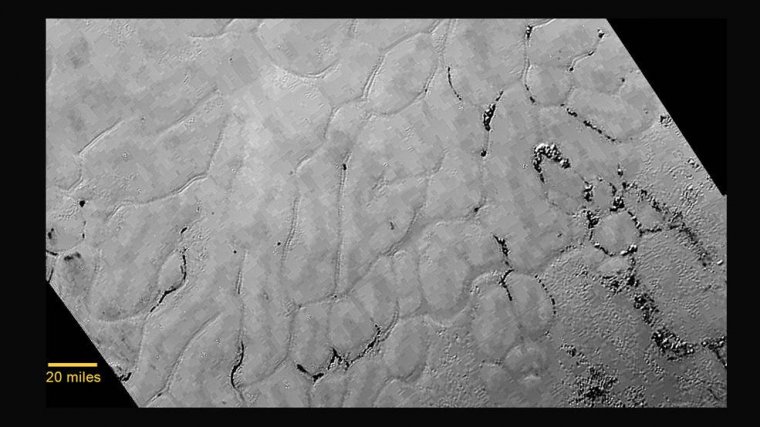| News / Space News |
New Horizons Discovers Frozen Plains in the Heart of Pluto’s ‘Heart’
NASA | JULY 19, 2015
In the latest data from NASA’s New Horizons spacecraft, a new close-up image of Pluto reveals a vast, craterless plain that appears to be no more than 100 million years old, and is possibly still being shaped by geologic processes.
This frozen region is north of Pluto’s icy mountains, in the center-left of the heart feature, informally named “Tombaugh Regio”.
This fascinating icy plains region -- resembling frozen mud cracks on Earth -- has been informally named “Sputnik Planum”. It has a broken surface of irregularly-shaped segments, roughly 12 miles (20 kilometers) across, bordered by what appear to be shallow troughs. Some of these troughs have darker material within them, while others are traced by clumps of hills that appear to rise above the surrounding terrain. Elsewhere, the surface appears to be etched by fields of small pits that may have formed by a process called sublimation, in which ice turns directly from solid to gas, just as dry ice does on Earth.
Pluto’s icy plains also display dark streaks that are a few miles long. These streaks appear to be aligned in the same direction and may have been produced by winds blowing across the frozen surface.
The New Horizons Atmospheres team observed Pluto’s atmosphere as far as 1,000 miles (1,600 kilometers) above the surface, demonstrating that Pluto’s nitrogen-rich atmosphere is quite extended.
The New Horizons Particles and Plasma team has discovered a region of cold, dense ionized gas tens of thousands of miles beyond Pluto -- the planet’s atmosphere being stripped away by the solar wind and lost to space.
YOU MAY ALSO LIKE



